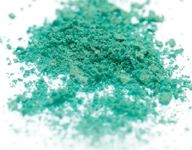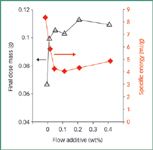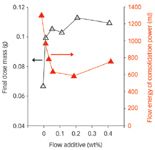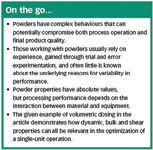Quantifying experience in powder processing
Pharmaceutical Technology Europe
Enshrined in the concept of Quality by Design is the premise that optimized pharmaceutical manufacturing requires detailed understanding of products and processes. With this in mind, many benefits can be achieved by combining modern powder characterization techniques with real processing experience.
Manufacturers routinely produce stable dosage forms by exploiting the unique properties of powders. Too often, however, powders display their complex behaviour in uncontrolled ways, potentially compromising process operation and final product quality. Those working with powders have always amassed experience through successful problem solving and, until recently, more fundamental knowledge has been scarce. Now, the techniques available for characterizing powder behaviour make it increasingly easy to combine experience and information, and to correlate process behaviour with a range of powder characteristics. Such correlations, developed using shear, dynamic and bulk property measurements to rationalize experience, extend our basic understanding, and make for better powder formulation and improved process design. Here, the example of volumetric dosing allows further experimentation and exploration of how this can work.

(Paul Tearle/Getty Images)
Why are powders challenging?
As many as a hundred different parameters can influence powder behaviour. The critical nature of air and moisture content is widely recognized in the process environment, but many other parameters are also important. Primary factors include particle size and distribution, shape, porosity, hardness and surface texture. Temperature, vibration, flow rate and storage time are all good examples of secondary or system variables.
This complexity makes it challenging to define, predict and measure powder properties. Consequently, in contrast to the situation for gases and liquids, there are few data available for the design, modification or troubleshooting of powder processes. A fundamental mathematical description of behaviour lies well beyond our current capabilities.
Unfortunately, the corollary of this is that powder behaviour is not easily controlled. Maintaining consistent behaviour can be very difficult when it demands close control of so many variables. For example, in the initial stages of a process, a powder may have sharp, needle-like particles, but if they are not strong then the size and shape distribution downstream will be markedly different. Flow properties are likely to be transformed. Alternatively, or indeed additionally, sensitivity to moisture content may be an issue. Variations in moisture content nearly always affect powder flowability, but the impact is particularly marked for very hygroscopic materials. A powder that flows freely when relatively dry may become much more cohesive if stored in damp conditions or processed in a humid environment.
Relevant data are required for optimal formulation, process design and operation, but it is not possible to define powder properties in terms of the many variables that influence them. The conventional response to this challenge has been to rely heavily on experiencebased development and operation; an approach that, by its nature, must be relatively inefficient.
Optimizing the value of experience
In general, experience is gathered through trial and error experimentation. For example, with time an operator may learn that material A processes easily at high rates while material B is more challenging, requiring careful control of specific variables and a much lower throughput. A third blend may prove almost impossible to process on the same line, but may be easy to handle in a different piece of equipment. Such experience is not easy to transfer, as it relates only to a specific powder or processing line. Often, little is known of the underlying reasons for the variability in performance.
Identifying the properties responsible for the excellent performance of powder A and the poor performance of B is the key to more fundamental process understanding; for example, powder A may perform well because it is freeflowing while B is more cohesive. If this is the case, then measuring terms that define these aspects of behaviour (e.g., specific energy (SE), basic flow energy (BFE), shear strength etc.) will facilitate the development of a specification for materials that process well.
Most companies have an extensive experience base, information and observations gathered at the formulation and process development stages as well as during daytoday operation. Correlating this experience with measured powder properties provides insight into the practical relevance of specific parameters, optimizing value. Such analysis narrows down the number of variables that could be influencing process behaviour to the few that actually are. When the factors influencing behaviour, or causing a problem, are understood, steps to change a process or formulation can be made on the basis of knowledge. Adoption of a knowledge-based approach is the key to Quality by Design (QbD).
Analysing processes
Powders exhibit different behaviours depending on how they are or have been treated. The key to effective processing is matching powder characteristics with the demands of specific unit operations. For example during direct compression tableting, a freeflowing powder must release air to form a stable tablet. If air is compressed with the dose then it will expand upon ejection from the die, breaking the tablet apart. Some powders release air relatively easily, but others do not. A tableting formulation that readily deaerates is preferable.
For a given unit operation, the processing problems encountered will depend on the properties of the powder being used. Powder blend A may flow easily from the hopper, but be prone to segregation, producing tablets of inconsistent composition. However, an alternative tableting formulation, B, may produce good quality tablets, but have a tendency to flow poorly and adhere to the press during manufacture. Unit operations are a series of microprocesses; some of which will 'suit' the powder and some of which will not. Analysis of these micro-processes and the demands they place on the powder is an effective starting point for process investigation.
Volumetric dosing
Consider volumetric dosing where the goal is to extract small representative doses from a larger bulk. Consistent dose weight is critical, but this parameter is checked postproduction rather than during manufacture. The required performance is achieved by filling a die of known volume with powder of consistent bulk density. Variability in either percentage fill or density will impact final dose weight.
Typically, the first stage of a volumetric dosing process involves the flow of powder into empty recesses. A powder sledge travels to and fro across the surface of the dies, filling them and scraping off excess powder. After a specified number of passes, filling stops and the confined powder plugs are compacted to a known degree between the upper and lower pins. The sample is ejected by removing the lower pin and punching the upper pin right through the die.
There are four significant microprocesses:
- die filling
- compaction of the dose
- retraction of the lower pins
- ejection.
The powder properties that influence the flow of material into the die are not necessarily those of most relevance when predicting, for example, compaction behaviour. Multifaceted powder characterization is so valuable because it allows identification of the properties most closely correlated with each aspect of the process. Therefore, it is preferable to use instruments that measure an array of powder properties, rather than a single variable or one type of parameter (shear, bulk or dynamic).
A study of volumetric dosing was conducted using a laboratoryscale rig, representative of fullscale processing equipment. The performance of different blends of corn starch, containing 0–0.4% by weight of a flow additive, (AEROSIL 200 fumed silica; Evonik Degussa GmbH, Germany) was assessed. Each of the blends was also characterized using an FT4 Powder Rheometer (Freeman Technology, UK). All stages of the volumetric dosing process were considered in turn.
Die-filling
The effectiveness of die filling is strongly influenced by the flow properties of the powder. Initially, powder flows into an empty recess: subsequent passes compress more powder into the die. The dies must be consistently filled to achieve consistent dose weight. So what are the important powder flow characteristics here?
A freeflowing powder will be released smoothly by the sledge and flow easily into the die in the initial stages. A more cohesive powder will tend to flow more erratically from the sledge and may bridge across the die opening inhibiting filling.
Once the recess is partially full, the powder is no longer unconfined, but is still required to 'flow'. Powders that flow freely when unconfined do not tend to move easily when subjected to compacting motion. More cohesive powders, however, 'extrude' into any available space as they are compacted. Both unconfined and consolidated flow behaviour are relevant factors here.
Measuring unconfined flow properties. The term 'unconfined' is used to refer to flow, usually under gravity, into an unconfined space. Both shear and dynamic measurements give insight into unconfined powder behaviour. Dynamic testing, with a powder rheometer, measures the powder in motion. The axial and rotational forces acting on a blade as it moves through a conditioned sample are measured to determine flow energy. For unconfined flow characterization, the rheometer blade is rotated upwards through the sample, producing shear, but little compression. The term measured, SE, is expressed per unit mass because of the impact of gravitational forces.
The ability to achieve reproducible powder flow measurements underpins the entire process. The term 'conditioned' is used to describe a sample that has been prepared so as to eliminate, where possible, the influence of processing history. Using a powder rheometer, conditioning involves gentle rotation of the blade through the sample. This releases excess air, breaks up any loose agglomerates and slightly aerates a compressed sample, creating a uniform homogeneously packed bed for measurement. The conditioning step ensures that samples are always measured in the same baseline state, and is used in many shear, bulk and dynamic measurements. As well as enhancing repeatability and reproducibility, it also enables successful differentiation between dissimilar samples.
During shear testing, an upper cell rotates relative to a stationary base plate, shearing one planar surface of the sample against another. The torque is measured to generate parameters such as unconfined yield stress, cohesion and angle of internal friction. Conventionally, tests are conducted using a compacted sample, and a constant applied normal stress. More recently, unconsolidated shear data have been produced by testing at normal stresses close to zero. This new approach to shear testing is welldocumented.1 Figure 1 shows the clear correlation between SE and unconsolidated shear data.

Figure 1: Shear stress of an unconsolidated powder in relation to the dynamic specific energy measurement of the unconsolidated powder.
Experimental data show that the SE of the corn starch blends used in the volumetric dosing study decreases to a minimum as flow additive concentration is increased (Figure 2). Smaller additive particles fit into the interstitices of the larger corn starch, lubricating flow. Above this optimum concentration, SE starts to rise once more as pockets of additive particles form, locking the powder and inhibiting flow.

Figure 2: Dose mass (compression ratio 20%) and specific energy for six blends.
Dose weight rises to a relatively steady value as SE falls. Therefore, the suggestion that better flow will enhance the effectiveness of die filling is supported by a correlation.
The influence of consolidation/compaction. Rotating a powder rheometer blade downwards rather than upwards through a conditioned sample produces a bull-dozing action that compresses the powder against the base of the sample vessel. The measurement made under these conditions is BFE and is highly differentiating. It reflects how a powder will behave when confined, such as in a partially filled die.
In general, BFE values correlate inversely with compressibility. Noncohesive powders with low compressibility tend to have relatively high BFE while more compressible, cohesive powders have much lower values. A rationalization for this is that if the powder has low compressibility then movement of the blade simultaneously sets more of the sample in motion and produces a large 'flow zone'. A compressible powder, conversely, tends to dampen or absorb motion in one part of the sample, reducing measured BFE. This is why cohesive powders move more easily under compacting conditions than noncohesive materials.2
The effect of consolidation can be studied more extensively by comparing BFE with the flow energy of samples subjected to a defined compaction process. Figure 3 shows how consolidated flow energy, the flow energy measured on a sample subjected to direct compression, varies with percentage mass of flow additive, for the corn blend system.

Figure 3: Dose mass (compression ratio 20%) and flow energy of six consolidated blends.
The results echo those for SE. The inclusion of flow additive reduces both SE and consolidated flow energy, therefore, improving initial and subsequent filling of the die.
Compression of the dose
In the compression step of the process, the upper punches are lowered to a known extent to axially compact the powder sample. Provided the die has been properly filled, it is the bulk property of compressibility that will be critical at this point. Axial compaction has less impact on a sample with higher compressibility than one that is relatively incompressible.
With a compressible sample, the compacting force tends to act locally only on the top surface. Just a fraction of the sample has to compress to absorb the movement of the upper punch. With lower compressibility, there is more effective transmission of the compacting force and more homogeneous compaction. Samples with lower compressibility tend to be more stable upon ejection with more consistent dose weight. Highly compressible blends produce samples that easily release bits of powder, varying the dose weight. Figure 4 shows how compressibility falls with increasing flow additive concentration and the corresponding dosage weight trend.

Figure 4: Dose mass (compression ratio 20%) and compressibility for six blends.
Retraction of the lower pins
At this point, the aim is for the compressed powder to remain in the die, rather than falling out or sticking to the lower pins; cohesive behaviour is highly relevant. The formulation must have the cohesion and compressive strength to support its own weight and remain in the die, yet not adhere to the lower pins. Figure 5 shows how shear strength decreases with increasing flow additive concentration for the corn starch blends.

Figure 5: Dose mass (compression ratio 20%) and shear stress (3 kPa) for six blends.
The process observations superimposed on this data show that, for this parameter, there is an optimal value. If shear stress is too high then there is adhesion to the pins and material is drawn out of the die as they are removed. However, if shear strength is too low the material falls out as the lower pins are withdrawn.
Ejection of the dose
The factors influencing the success of dose ejection are similar to those of the previous stage. The dose must hold its shape and not adhere to the upper pins as they punch through the die. Optimal cohesive strength is key. The corn starch blends with very low levels of flow additive (0 and 0.02%) are very cohesive. Samples made with these materials break up on ejection, with some material remaining stuck to the upper pins. Once cohesion is reduced, dose ejection is successfully achieved.
Enhanced process understanding
In the case reported here, processing was simulated by conducting simple tests on a laboratoryscale volumetric dosing rig. This experience was then correlated with various shear, bulk and dynamic powder properties. Within an industrial setting, an analogous approach would generate valuable correlations from the existing experience base. The essential conclusion of this work is that the performance of powders in the process studied is dependent on flow characteristics (unconfined and consolidated), compressibility and cohesive strength. However, this is simply confirmation of knowledge that many experienced processors would already have.
The real value of the analysis is that the correlations between performance and powder behaviour have been quantified. Powders with SE, consolidated flow energy, compressive strength and compressibility values in a certain range will process well in this operation. Powders with properties outside this range will not. All are properties that can be measured easily and reproducibly.

On the go...
If a new formulation for volumetric dosing is required, there is now a sound basis for predicting its performance. If a formulation is processing poorly it is possible to identify the parameter responsible and make changes on the basis of this knowledge. The exercise has provided insight into powder behaviour that has applications beyond the confines of this particular experiment. Formulation, process development and operational experience can all be rationalized by taking this approach. In each case, the result are correlations that enhance process knowledge and understanding.
Conclusion
No one would claim that powders are simple to process, but there are ways of characterizing them that provide valuable process insight. Simplistically, powders are thought of as 'good' or 'bad', but this is not the case. Powder properties have absolute values, but processing performance depends on the interaction between material and equipment.
The example of volumetric dosing demonstrates how dynamic, bulk and shear properties can all be relevant in the optimization of a single unit operation. This highlights the effectiveness of a multifaceted approach to powder testing and the advantage of instruments that provide comprehensive analysis. Correlating experience, both new and existing, with measurable powder properties is a powerful way of identifying the critical variables determining performance, a key aim for QbD. Understanding how these variables influence behaviour is vital for effective powder formulation, improved process design, better process/powder matching and optimal process control.
Tim Freeman is Director of Operations at Freeman Technology Ltd (UK).
References
1. R.E. Freeman, J.R. Cooke and L.C.R. Schneider, "Measuring shear properties and normal stresses generated within a rotational shear cell for consolidated and non-consolidated powders," at the French Symposium on Powder Science and Technology (France, May 2007).
2. R. Freeman and X. Fu, "Measuring Powder Characteristics Relating To Forced Flow Into Confined Spaces Using A Universal Powder Tester," at Particulate Systems Analysis 2008 (UK, September 2008).

Drug Solutions Podcast: A Closer Look at mRNA in Oncology and Vaccines
April 30th 2024In this episode fo the Drug Solutions Podcast, etherna’s vice-president of Technology and Innovation, Stefaan De Koker, discusses the merits and challenges of using mRNA as the foundation for therapeutics in oncology as well as for vaccines.
Pharmaceutical Tariffs Are Imminent: How Industry is Bracing for Impact
April 16th 2025On April 14, 2025, the Trump Administration launched a national security-driven investigation into pharmaceuticals, a move that will likely result in tariffs being placed on pharmaceutical drugs, ingredients, and other components that are imported from outside of the United States.